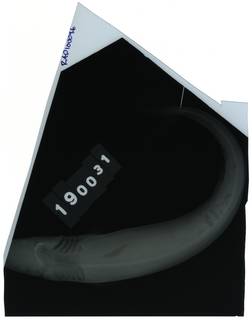PeRMS taxon details
Euprotomicrus bispinatus (Quoy & Gaimard, 1824)
215608 (urn:lsid:marinespecies.org:taxname:215608)
accepted
Species
marine, brackish, fresh, terrestrial
(of ) Quoy, J. R. C.; Gaimard, J. P. (1824-1825). Description des Poissons. Chapter IX. <em>In: Freycinet, L. de, Voyage autour du Monde...exécuté sur les corvettes de L. M.</em> 192-401 [1-328 in 1824; 329-616 in 1825], Atlas pls. 43-65., available online at https://www.biodiversitylibrary.org/page/40871183#page/204/mode/1up [details]
Description Occurs at or near the surface at night and apparently descends to at least midwater depths (below 300 m) during the day....
Description Occurs at or near the surface at night and apparently descends to at least midwater depths (below 300 m) during the day. Vertical migration extends to great distances, at least 1500 m each way. Sand grains found in the stomach suggests that it may be a bottom-feeder. Food includes squid, bony fishes, with some crustaceans. Ovoviviparous with 8 young per litter. Caught with dip-nets and buckets at night (Ref. 6577). [details]
Froese, R. and D. Pauly. Editors. (2025). FishBase. Euprotomicrus bispinatus (Quoy & Gaimard, 1824). Accessed through: Santamaría, J.; Romero, C.; Meza, M. (Eds) (2025) Peruvian Register of Marine Species at: https://marinespecies.org/Perms/aphia.php?p=taxdetails&id=215608 on 2025-06-02
Santamaría, J.; Romero, C.; Meza, M. (Eds) (2025). Peruvian Register of Marine Species. Euprotomicrus bispinatus (Quoy & Gaimard, 1824). Accessed at: https://marinespecies.org/perms/aphia.php?p=taxdetails&id=215608 on 2025-06-02
Date
action
by
original description
(of ) Quoy, J. R. C.; Gaimard, J. P. (1824-1825). Description des Poissons. Chapter IX. <em>In: Freycinet, L. de, Voyage autour du Monde...exécuté sur les corvettes de L. M.</em> 192-401 [1-328 in 1824; 329-616 in 1825], Atlas pls. 43-65., available online at https://www.biodiversitylibrary.org/page/40871183#page/204/mode/1up [details]
context source (Deepsea) Intergovernmental Oceanographic Commission (IOC) of UNESCO. The Ocean Biogeographic Information System (OBIS), available online at http://www.iobis.org/ [details]
context source (PeRMS) Chirichigno, N.; Cornejo, M. (2001). Catálogo comentado de los peces marinos del Perú. <em>2ª ed. Instituto del Mar de Perú. Publicación Especial. Callao.</em> 314 p. [details]
basis of record Froese, R. & D. Pauly (Editors). (2025). FishBase. World Wide Web electronic publication. version (06/2024)., available online at https://www.fishbase.org [details]
additional source King, C.M.; Roberts, C.D.; Bell, B.D.; Fordyce, R.E.; Nicoll, R.S.; Worthy, T.H.; Paulin, C.D.; Hitchmough, R.A.; Keyes, I.W.; Baker, A.N.; Stewart, A.L.; Hiller, N.; McDowall, R.M.; Holdaway, R.N.; McPhee, R.P.; Schwarzhans, W.W.; Tennyson, A.J.D.; Rust, S.; Macadie, I. (2009). Phylum Chordata: lancelets, fishes, amphibians, reptiles, birds, mammals. <em>in: Gordon, D.P. (Ed.) (2009). New Zealand inventory of biodiversity: 1. Kingdom Animalia: Radiata, Lophotrochozoa, Deuterostomia.</em> pp. 431-554. [details]
ecology source Looby, A.; Erbe, C.; Bravo, S.; Cox, K.; Davies, H. L.; Di Iorio, L.; Jézéquel, Y.; Juanes, F.; Martin, C. W.; Mooney, T. A.; Radford, C.; Reynolds, L. K.; Rice, A. N.; Riera, A.; Rountree, R.; Spriel, B.; Stanley, J.; Vela, S.; Parsons, M. J. G. (2023). Global inventory of species categorized by known underwater sonifery. <em>Scientific Data.</em> 10(1). (look up in IMIS), available online at https://doi.org/10.1038/s41597-023-02745-4 [details]
context source (Deepsea) Intergovernmental Oceanographic Commission (IOC) of UNESCO. The Ocean Biogeographic Information System (OBIS), available online at http://www.iobis.org/ [details]
context source (PeRMS) Chirichigno, N.; Cornejo, M. (2001). Catálogo comentado de los peces marinos del Perú. <em>2ª ed. Instituto del Mar de Perú. Publicación Especial. Callao.</em> 314 p. [details]
basis of record Froese, R. & D. Pauly (Editors). (2025). FishBase. World Wide Web electronic publication. version (06/2024)., available online at https://www.fishbase.org [details]
additional source King, C.M.; Roberts, C.D.; Bell, B.D.; Fordyce, R.E.; Nicoll, R.S.; Worthy, T.H.; Paulin, C.D.; Hitchmough, R.A.; Keyes, I.W.; Baker, A.N.; Stewart, A.L.; Hiller, N.; McDowall, R.M.; Holdaway, R.N.; McPhee, R.P.; Schwarzhans, W.W.; Tennyson, A.J.D.; Rust, S.; Macadie, I. (2009). Phylum Chordata: lancelets, fishes, amphibians, reptiles, birds, mammals. <em>in: Gordon, D.P. (Ed.) (2009). New Zealand inventory of biodiversity: 1. Kingdom Animalia: Radiata, Lophotrochozoa, Deuterostomia.</em> pp. 431-554. [details]
ecology source Looby, A.; Erbe, C.; Bravo, S.; Cox, K.; Davies, H. L.; Di Iorio, L.; Jézéquel, Y.; Juanes, F.; Martin, C. W.; Mooney, T. A.; Radford, C.; Reynolds, L. K.; Rice, A. N.; Riera, A.; Rountree, R.; Spriel, B.; Stanley, J.; Vela, S.; Parsons, M. J. G. (2023). Global inventory of species categorized by known underwater sonifery. <em>Scientific Data.</em> 10(1). (look up in IMIS), available online at https://doi.org/10.1038/s41597-023-02745-4 [details]
 Present
Present  Inaccurate
Inaccurate  Introduced: alien
Introduced: alien  Containing type locality
Containing type locality
Unreviewed
Description Occurs at or near the surface at night and apparently descends to at least midwater depths (below 300 m) during the day. Vertical migration extends to great distances, at least 1500 m each way. Sand grains found in the stomach suggests that it may be a bottom-feeder. Food includes squid, bony fishes, with some crustaceans. Ovoviviparous with 8 young per litter. Caught with dip-nets and buckets at night (Ref. 6577). [details]
| Language | Name | |
|---|---|---|
| English | pygmy shark | [details] |
| French | squale pygmée | [details] |
| Russian | Карликовая светящаяся акула | [details] |
| Spanish | tiburón pigmeo | [details] |
To Barcode of Life (2 barcodes)
To Biodiversity Heritage Library (20 publications)
To European Nucleotide Archive, ENA (Euprotomicrus bispinatus)
To FishBase
To FishBase images (Euprotomicrus bispinatus, by FAO)
To GenBank (11 nucleotides; 17 proteins)
To Global Biotic Interactions (GloBI)
To IUCN Red List (Least Concern)
To NMNH Extant Collection (Euprotomicrus bispinatus RAD100096-001)
To NMNH Extant Collection (Euprotomicrus bispinatus RAD100096-001)
To ITIS
To Biodiversity Heritage Library (20 publications)
To European Nucleotide Archive, ENA (Euprotomicrus bispinatus)
To FishBase
To FishBase images (Euprotomicrus bispinatus, by FAO)
To GenBank (11 nucleotides; 17 proteins)
To Global Biotic Interactions (GloBI)
To IUCN Red List (Least Concern)
To NMNH Extant Collection (Euprotomicrus bispinatus RAD100096-001)
To NMNH Extant Collection (Euprotomicrus bispinatus RAD100096-001)
To ITIS










